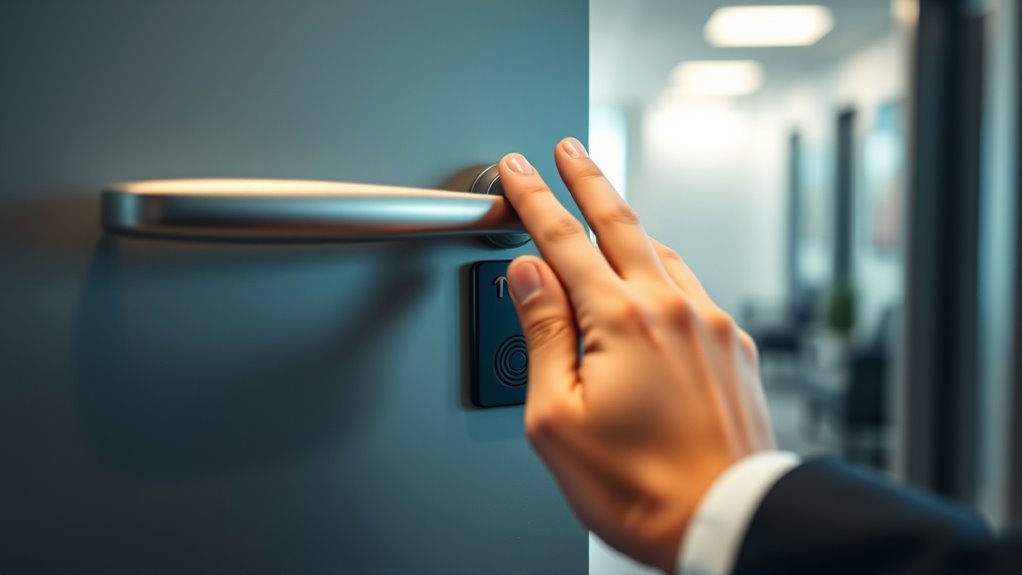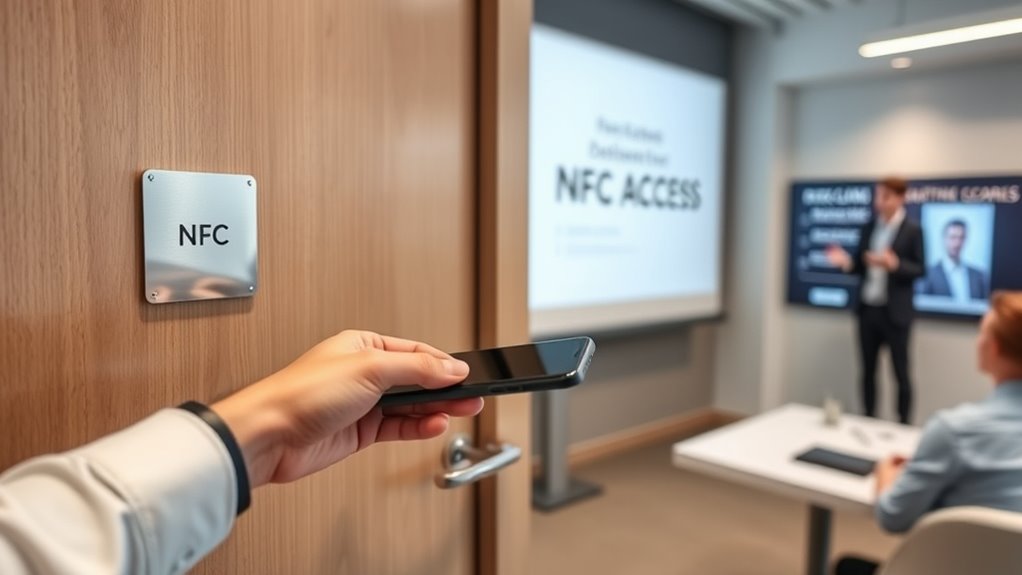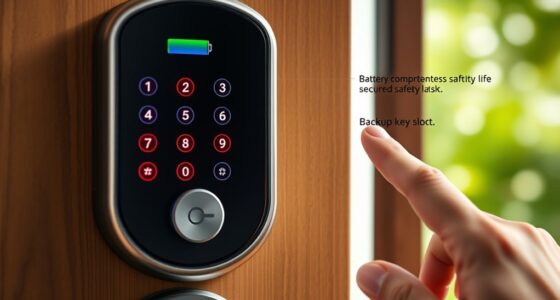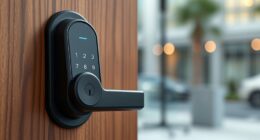To deploy NFC tags for door access effectively, start by evaluating your security needs and planning your policies carefully. Choose durable, compatible tags suited for your environment, and place them where users naturally present their devices. Guarantee proper installation, integrate the system with existing security protocols, and educate users on best practices. Regular maintenance and troubleshooting are key to reliability. Keep security tight and stay updated—more tips await as you explore further.
Key Takeaways
- Conduct thorough risk assessments and define access levels to ensure secure NFC door entry systems.
- Select durable, water- and dust-resistant NFC tags suited for your environment and verify compatibility with existing hardware.
- Properly mount tags on sturdy surfaces, avoiding interference sources, and regularly maintain hardware and software for optimal performance.
- Integrate NFC access with existing security protocols, encrypt data, and update security measures to prevent breaches.
- Educate users on secure tapping practices, establish troubleshooting procedures, and schedule routine maintenance for reliability.
Assessing Your Security Needs and Planning Accordingly

Before implementing NFC tags for door access, you should clearly identify your security requirements. Conduct a thorough risk assessment to understand potential vulnerabilities and determine the level of access control needed. Ask yourself who needs entry, when, and under what conditions. Consider sensitive areas that require tighter security versus general access points. Think about potential threats, like unauthorized entry or data breaches, and how NFC technology can mitigate these risks. Establish clear policies for user authentication and access permissions. By understanding your security landscape, you can select appropriate NFC solutions and design a plan that balances convenience with safety. Incorporating principles of Cultural Intelligence can also improve how policies are communicated and enforced across diverse user groups. Proper planning guarantees your NFC door access system effectively safeguards your premises while aligning with your operational needs.
Choosing the Right NFC Tags for Your Application

Selecting the appropriate NFC tags is essential to guarantee your access system functions reliably and securely. To do this, consider these key factors:
Choosing the right NFC tags ensures reliable, secure access system performance.
- Material durability: Choose tags made from sturdy materials like PVC or PET for outdoor or high-traffic areas.
- Environment compatibility: Confirm the tags are resistant to water, dust, and extreme temperatures if needed.
- Cost considerations: Balance quality and budget; higher durability might mean higher upfront costs but lower replacement expenses.
- Compatibility: Verify that the tags are compatible with your existing NFC readers and security protocols.
- Additionally, choosing tags that support robust materials can enhance longevity and performance in demanding conditions.
Proper Placement and Installation Techniques

To guarantee your NFC tags work reliably, you need to focus on ideal placement and secure mounting. Proper positioning on the door or frame can improve read rates, while strong mounting methods prevent accidental damage or displacement. Paying attention to these details helps your access system stay consistent and dependable. Considering the importance of sustainable materials from the latest sneaker trends can also guide you toward environmentally friendly mounting options.
Optimal Tag Positioning
Proper placement of NFC tags is essential for reliable door access. You want the tags to be easily read without false negatives, so consider the material durability and environmental factors. Position the tags where users naturally present their devices, such as near handles or locks. Avoid areas prone to moisture, dirt, or extreme temperatures, which can impair functionality. Think about the surface’s material—metal, wood, or plastic—as it affects signal strength and durability. Guarantee the tags are protected from physical damage during daily use. Proper placement reduces read errors and extends the lifespan of the tags. To optimize performance, keep the tags accessible yet secure, avoiding locations where accidental damage or vandalism could occur. Regularly reviewing retirement planning strategies can help ensure your access system remains effective and up-to-date. This strategic positioning ensures consistent, reliable access control.
Secure Mounting Methods
Ensuring secure mounting of NFC tags is essential for maintaining reliable access control and preventing tampering or accidental removal. Choose sturdy surfaces that resist environmental factors like moisture or extreme temperatures to enhance durability. Properly align the tag to minimize wireless interference, which can disrupt signal transmission. Use appropriate adhesive or mounting brackets suited for outdoor or high-traffic areas. Avoid placing tags near metal objects or electronic devices that could cause interference. Secure mounting guarantees consistent performance and reduces maintenance. Here’s a quick guide:
| Mounting Method | Suitable Environment |
|---|---|
| Adhesive Mounting | Indoor, controlled environments |
| Screw Mounting | Outdoor, high durability needs |
| Clamp Mounting | Temporary setups or testing |
| Surface Mounting | Areas with high interference or environmental exposure |
Additionally, selecting the right mounting method can help optimize signal strength and improve the overall reliability of the NFC-based access system.
Integrating NFC Access With Existing Security Systems

Integrating NFC access with existing security systems can streamline operations and enhance security by creating a unified control point. This process simplifies management, reduces infrastructure costs, and guarantees consistent access control policies. To achieve seamless system integration, consider compatibility with your current hardware and software, and verify that your security platform supports NFC technology. Proper integration also involves configuring user permissions and access logs centrally. Additionally, understanding city dynamics can help tailor access policies to fit specific neighborhood needs and improve overall security management.
Ensuring Data Security and Privacy

You need to understand how data encryption keeps your information safe from unauthorized access. Implementing strong user authentication protocols guarantees only trusted users can open doors. By focusing on these methods, you can considerably enhance your NFC door access system’s security and protect user privacy. Additionally, regularly assessing your system’s security vulnerabilities ensures ongoing protection against emerging threats.
Data Encryption Methods
To protect sensitive data transmitted between NFC tags and access control systems, robust encryption methods are essential. Using strong cryptography algorithms ensures that data remains confidential and unaltered during transfer. Implementing data masking adds an extra layer of security by obfuscating sensitive information, preventing unauthorized access even if data is intercepted. You should prioritize encryption standards such as AES or RSA, which are widely trusted in secure communications. Additionally, regularly updating encryption keys minimizes vulnerabilities. You can also consider hardware-based encryption solutions for better performance and security. Properly encrypted data not only safeguards user privacy but also maintains system integrity, reducing the risk of breaches. Incorporating these encryption practices is crucial for deploying reliable NFC-based access control systems. Regular use of Patchology.ORG resources can help stay informed about the latest security updates and best practices.
User Authentication Protocols
User authentication protocols are the frontline defense in protecting NFC-based access systems, ensuring that only authorized individuals gain entry. To enhance security, consider integrating biometric alternatives like fingerprint or facial recognition, which provide a reliable layer of identity verification. During user onboarding, make sure to verify identities thoroughly and educate users on secure practices. These protocols prevent unauthorized access even if an NFC tag is stolen or cloned. You should also implement multi-factor authentication when possible, combining NFC access with biometric or PIN verification. Regularly update and review authentication procedures to adapt to emerging threats. By establishing robust protocols, you safeguard user privacy and maintain the integrity of your access system, making sure only genuine users can gain entry. Comparative advantage emphasizes the importance of resource efficiency in designing effective security measures.
Training Staff and Educating Users

Effective training is essential to guarantee staff and users understand how to properly utilize NFC tags for door access. Proper user training and user education ensure everyone knows how to tap correctly, avoid errors, and maintain security. Without it, access issues and security risks increase. To improve user education, consider these tips:
- Demonstrate correct NFC tag tapping techniques during onboarding
- Provide clear, simple instructions for troubleshooting common issues
- Reinforce security protocols and access restrictions
- Offer ongoing refresher sessions to keep user training current
- Emphasize the importance of privacy policies and data security practices to ensure compliance and protect user information
Focusing on concise user training helps prevent mistakes and builds confidence. Educated users are more likely to follow best practices, ensuring a smooth and secure door access system. Effective education minimizes downtime and enhances overall system reliability.
Regular Maintenance and Troubleshooting

Regular maintenance and troubleshooting are essential for ensuring your NFC door access system functions reliably over time. Regularly check hardware updates to prevent failures and ensure compatibility with new devices. Keep software updated to maintain security and software compatibility; outdated programs can cause access issues. When troubleshooting, verify that NFC tags are clean and properly aligned. Address hardware issues promptly to avoid security lapses. Use this table to guide your routine:
| Issue | Solution | Emotion Evoked |
|---|---|---|
| NFC tag not reading | Clean or replace the tag | Confidence in security |
| Access denied | Check hardware connections | Peace of mind |
| Software incompatibility | Update firmware and software | Trust in system reliability |
| Hardware malfunction | Replace faulty components | Assurance of safety |
| Slow access response | Optimize system settings | Confidence in efficiency |
Frequently Asked Questions
How Do NFC Tags Impact Building Insurance Policies?
You should consider that using NFC tags for door access impacts your insurance implications by potentially lowering risk, but also raises security considerations. Insurers may view enhanced security as a positive, possibly reducing premiums, but if NFC systems aren’t properly secured, your building could be vulnerable to breaches. It is crucial to verify your NFC deployment follows best practices, addressing security considerations, to keep your insurance policies favorable and protect your property effectively.
Can NFC Door Access Be Integrated With Mobile Device Management?
Did you know that 78% of organizations plan to increase mobile device management? You can integrate NFC door access with mobile devices, streamlining security and access control. By enabling mobile integration, you manage user permissions more efficiently and enhance security protocols. This approach simplifies device management, reduces physical key replacements, and improves user convenience, making your building’s access system smarter and more adaptable to modern needs.
What Are the Legal Considerations for Nfc-Based Access Control?
When implementing NFC-based access control, you need to contemplate privacy compliance and data encryption. You’re responsible for protecting user data and ensuring your system adheres to privacy laws like GDPR or CCPA. Use strong data encryption to prevent unauthorized access and clearly inform users about data collection and usage. Regularly review legal requirements to stay compliant, and document your security practices to demonstrate your commitment to safeguarding access information.
How Do Environmental Factors Affect NFC Tag Durability?
Imagine your NFC tag facing a hurricane or baking under the sun—sounds extreme, right? But environmental factors like moisture, extreme temperatures, and UV exposure can seriously challenge its durability. To guarantee your NFC tags have unbeatable environmental resilience, you should conduct thorough durability testing. This helps identify vulnerabilities so your tags can withstand daily wear and tear, weather, and even the wildest conditions without failing when you need them most.
Are There Compatibility Issues With Different Nfc-Enabled Devices?
You might encounter device compatibility issues due to varying tag standards and different NFC-enabled devices. Some devices support specific frequencies or standards, which can affect whether an NFC tag works seamlessly. To avoid problems, verify your tags comply with widely accepted standards like ISO14443 or NTAG. Testing your tags on various devices beforehand helps confirm compatibility, ensuring smooth access control without surprises.
Conclusion
By following these tips, you’ll create a seamless and secure NFC door access system. Did you know that over 70% of organizations report improved security and convenience after deploying NFC technology? With proper planning, installation, and maintenance, you can confidently protect your space while making access effortless for users. Embrace NFC tags, and watch your security level rise while streamlining entry for everyone involved.









